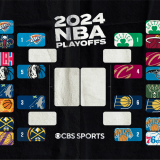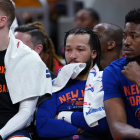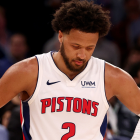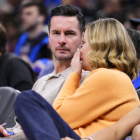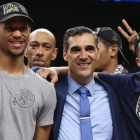For many franchises, the signing of Joakim Noah to a four-year contract worth more than $72 million would loom as an easy touchstone for operational futility. There are many reasons for this, ranging from Noah’s on-court play to the recent 20-game suspension for using performance-enhancing drugs, not to mention the opportunity costs both of rostering him and losing the players in the companion trade for Derrick Rose that led to signing him.
Still, you know that expression about New York: if you can make it there, you’ll make it anywhere. This is no truer than in the ample competition for the worst moves in Knicks history, the mecca of messes, where Noah’s acquisition might not even sit top of the heap.
Let’s examine the Noah case first. There are elements present in every Knicks’ epic decision failure, and all are here with Noah. Was there evidence that the player in question had declined beyond a capacity to help the team? Why yes. Noah’s injuries limited him to just 29 games last season. His middling offensive game had devolved into a real anchor on his value, with an OBPM in the negative range two years running. So that’s part one.
There’s more, though. Was Noah overpaid? Certainly, considering his value fell somewhere near the bottom of NBA centers, $18 million per season is a bit much. Did his acquisition lead to opportunity cost? Absolutely, though it is hard to pin down precisely who the team lost out on in free agency, that salary slot could have been used on many other valuable players. Then there’s the fact that they traded Robin Lopez -- a better, younger, more durable player under contract for fewer years at less money -- to create room for Noah. Then there’s the added fact that the team’s most important player, Kristaps Porzingis, should play the five as much as possible, and Noah theoretically blocked him from this.
Still, some of the debacle is theoretical. Will the Knicks continue using Noah at the five when he returns from his drug suspension next season at the expense of Porzingis’ development? He’s under contract for three more seasons after this one, after all. Will they ultimately trade Noah, and be forced to give up assets like draft picks to get his contract off the books? Will Noah’s injuries abate enough to play at the once-great level that led the Knicks to bring him in, hoping for a return to the past, or will his skills devolve further, the way the aging process usually works? Stay tuned on it all.
Still, let’s try and compare Noah to the biggest challengers he’ll face in recent history of Knick debacles.
Noah’s been worth 2.3 win shares in 46 games as a Knick. So in terms of pure value, he’s closing in fast on Andrea Bargnani, who registered 2.4 wins over 71 games in two seasons with New York. But there is so much more to the Bargnani deal than just tepid production punctuated by injuries.
The Knicks traded the following for Bargnani back in 2013: Marcus Camby, Steve Novak, Quentin Richardson, a 2016 first-round pick and two second-round picks -- one in 2014, one in 2017. The first rounder ended up a lottery selection, ninth overall, utilized by Toronto. And the 2017 pick means the Knicks still haven’t finished paying for the Bargnani deal.
Bonus: the first rounder they gave up meant they did not have a first rounder to deal for Kyle Lowry, a potential franchise-shifting player.
So Noah has to rank behind Bargnani. They both pale in comparison to Eddy Curry, of course.
In Curry’s defense, his total contribution to the effort far outstrips Noah to date or Bargnani overall. He posted 9.3 win shares over five seasons in 222 games as a Knick. But let’s not ignore the way he got it, or how he came and went.
Curry came to the Knicks in a massive deal from the Bulls, despite existing questions about both his conditioning and health that proved to be well-founded. What did the Knicks give up to get him in October 2005? Deep breath: They gave up Jermaine Jackson, Mike Sweetney (their 2003 lottery pick), Tim Thomas (a 1997 lottery pick who went on to play another half-dozen seasons in the league), a 2006 unprotected lottery pick (who became LaMarcus Aldridge), a 2007 unprotected lottery pick (who became, yes, Joakim Noah), a 2007 second-round pick and a 2009 second-round pick.
Curry’s value mostly came in his first two seasons, and overwhelmingly on the offensive end. At that point, health got the best of him, and he played 59 games in 2007-08, three games in 2008-09 and seven games in 2009-10 as the team dug out from under all the Isiah Thomas mistakes thanks to Donnie Walsh. Curry ultimately left town officially in the omnibus Carmelo Anthony deal, and played his final games in the league for the Mavericks in 2012-13. Also in 2012-13? LaMarcus Aldridge made his second NBA All-Star team, and Noah led the league in Defensive BPM.
So you must be wondering: How can the Noah debacle surpass Bargnani and Curry? It won’t be easy, but a rough estimate is this: The Knicks keep on using Noah at the five instead of Porzingis, leading the lone hopeful note on the roster to ask out of New York. The Knicks trade something really valuable, like a lottery pick that becomes first overall, as part of a sweetener to get out from under Noah’s contract. Just seeing Noah continue to struggle to stay healthy and underperform won’t be enough to cut it.
And we haven’t even talked about Jerome James or Michael Ray Richardson.
You see, this isn’t just any history the Joakim Noah debacle is going up against. These are the New York Knicks.












